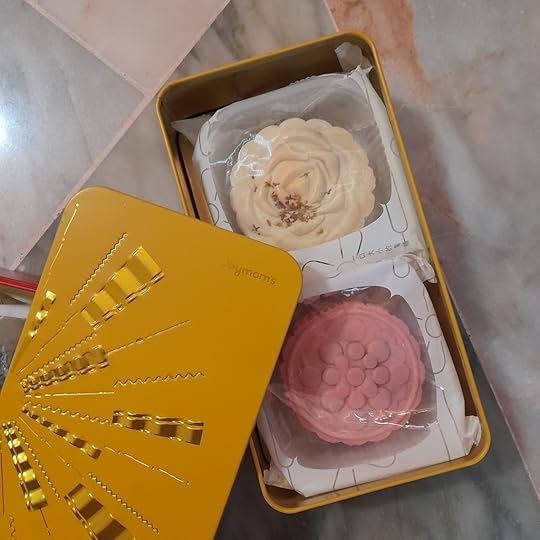Mooncake
Mooncake Festival is here, or more accurately, Mid-Autumn Festival. The date itself usually falls on the 15th day of the 8th month of the Chinese lunar calendar (each year it moves – not a fixed date). This year, it’s on September 29th. This is a day when we appreciate the moon with our family while eating mooncakes and drinking tea. It symbolizes family reunion (like the full moon) and is a day of thanksgiving for a good harvest or a harmonious union.
My focus in this post, however, is not the story behind Mid-Autumn Festival but the delightful and diverse dessert, mooncakes. These tiny desserts are packaged in metal tin boxes, typically containing four mooncakes packed tightly inside. You can buy them individually or in sets of four. When I was young, there were some traditional mooncakes, like red bean ones, smaller in size, sold in packs of six or eight, tightly wrapped like a roll.
However, these types aren’t as common nowadays and can mainly be found in traditional stores.
Mooncakes have evolved over the years. When I was a child, all we had were traditional mooncakes with baked brown skins and different fillings such as Red Bean, White Lotus/Lotus Paste, Wu Ren (Five Nuts), and Jin Hua Ham (Golden Ham with Assorted Nuts). But as time passed, so did the diversity of mooncakes. People started experimenting with mooncakes, creating snowskin mooncakes which need to be kept cold (and eaten cold as well, but not too cold, or else they will become hard and won’t taste as good).
In addition to snowskin, there’s also a pastry/layered type called Shanghai Mooncake, which features a distinct layer of yellowish, crisp, and crumbly outer layer.
However, it’s not just the skins that changed; the fillings did too. From the traditional flavors I mentioned earlier, we now have a variety of fillings (sometimes kneaded into the skin as well) made from fruits, nuts, and even western ingredients like dragon fruit, durian, mangoes, lychee, purple yam, pumpkin, sakura flower, black sesame, custard, chocolate, coffee, tiramisu, oreo, and even truffle-flavored pastes.
(The most expensive mooncake ever made in 2020 by Singapore (24K Truffle Mao Shan Wang Snowskin Mooncake) and 2017 by a Malaysian bakery with 17 types of premium ingredients – read more through the link here.)
Tea didn’t escape people’s creativity either; there were Dragon Well, Rose Tea, Puer Tea, Green Tea (very popular) mooncakes, but I disliked this type as the flavor was too subtle, and I felt like I couldn’t taste the tea in it.
That’s not all; some even layer mooncakes with mochi inside to enhance the texture when biting into the mooncake or made the filling like lava (you know like lava cakes but in a mooncake now).
In recent years, even regional tastes not traditionally associated with the Mid-Autumn Festival have been embraced. Now we also see new flavors like bubu chacha, cempedak (jackfruit), kaya (a local paste made of coconut, butter, and pandan leaves), Butterfly Pea flavor, cendol gula melaka, and many more.
The list seems endless, and there can be so many combinations of flavors as well. The ones I mentioned are all popular or more common in Malaysia; I haven’t even touched on the varieties of mooncakes available in different states in Malaysia, but I think I will save that for another post (this post is already very long, haha).
While I have a fondness for traditional mooncakes, I’m open to trying new flavors; it’s quite intriguing.
I hope that through this post, I can pique your curiosity and inspire you to give one a try.
This isn’t a paid promotion of this brand of mooncake (Joymom’s), but I really like them. These are the ones that I mean when I am talking about traditional mooncakes and the more common flavors that I enjoy. Below are some of them.
 Baked Skin Traditional Mooncake (Pandan Mung Bean, Pandan Lotus, and
Baked Skin Traditional Mooncake (Pandan Mung Bean, Pandan Lotus, and White Lotus Paste) I already ate one so there’s missing one in the box.
 Mooncake in packs of four (Clockwise: Lava Black Sesame, Lava Tiramisu, Black Sesame Yam, Dragon Fruit with Cranberry)
Mooncake in packs of four (Clockwise: Lava Black Sesame, Lava Tiramisu, Black Sesame Yam, Dragon Fruit with Cranberry) Mooncake in packs of two ( Top to bottom : Osmanthus Lotus and Pandan Black Sesame Mooncake)
Mooncake in packs of two ( Top to bottom : Osmanthus Lotus and Pandan Black Sesame Mooncake)I took some close up so you can see how that they all have different patterns on top. They are usually in flowers patterns but the more traditional ones had words on them but the patterns differs from bakery to bakery so not all of them will have the same appearance even though they have the same flavour.




Wishing you a Happy Mid-Autum Festival 2023!



